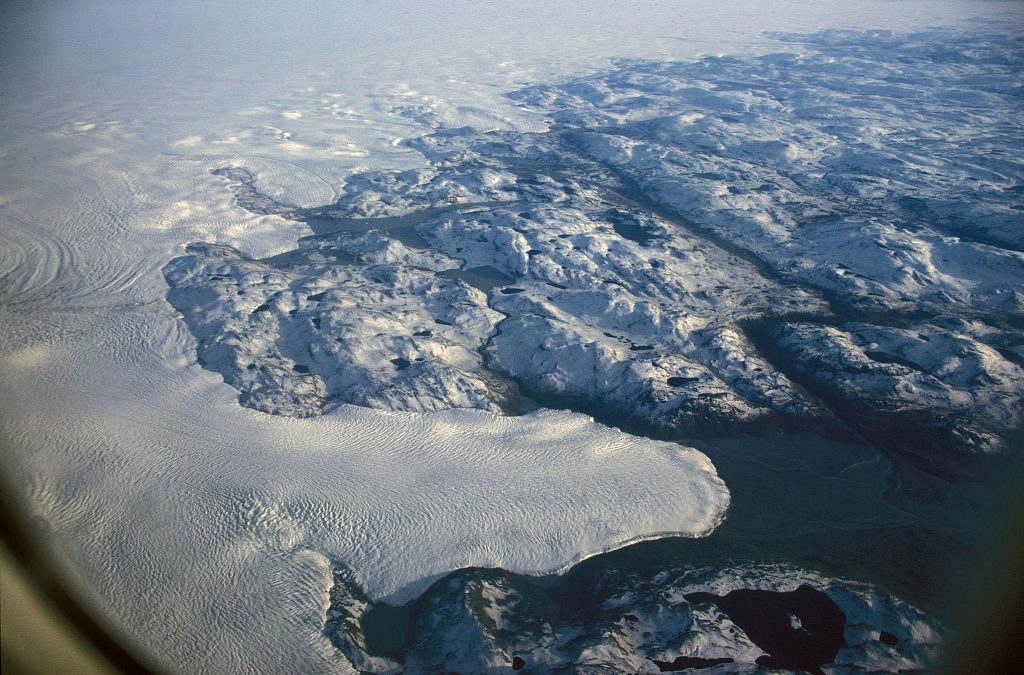27 October 2020

An aerial view of the Greenland ice sheet taken in September 1992. New research finds ice loss has accelerated significantly over the past two decades, transforming the shape of the ice sheet edge and therefore coastal Greenland.
Credit: Hannes Grobe, Alfred Wegener Institute for Polar and Marine Research (Own work), CC BY-SA 2.5.
AGU press contact:
Lauren Lipuma, +1 (202) 777-7396, [email protected]
Contact information for the researchers:
Twila Moon, National Snow and Ice Data Center, [email protected], [email protected]
WASHINGTON—Ice loss from the Greenland Ice Sheet has accelerated significantly over the past two decades, transforming the shape of the ice sheet edge and therefore coastal Greenland, according to new research.
A new study in AGU’s Journal of Geophysical Research: Earth Surface, which publishes research on the processes affecting the form and function of Earth’s surface, finds these changes could have far-reaching impacts on ecosystems and communities as the flow of water, nutrients and sediments under the ice sheet are altered.
“The speed of ice loss in Greenland is stunning,” said Twila Moon, deputy lead scientist at the National Snow and Ice Data Center in Boulder, Colorado and lead author of the new study. “We can now see many signs of a transformed landscape from space. And as the ice sheet edge responds to rapid ice loss, the character and behavior of the system as a whole is changing, with the potential to influence ecosystems and people who depend on them.”
In the new study, researchers compiled data from NASA, USGS and other satellites from 1985 to 2015 to compare ice edge position, ice sheet surface elevation, and glacier flow over three decades. Advancements in satellite technology allowed them to observe the changes to the ice sheet in much greater detail than was possible in the past.
Using these comparisons, the researchers developed a few key findings. The most consistent trend, found across the entire ice sheet, is widespread ice edge retreat. While there is a range of behavior among glaciers across the ice sheet, there is a noticeable lack of sustained ocean-connected glacier advance. Out of 225 ocean-connected glaciers that were measured, none have substantially advanced while 200 have retreated, particularly since the year 2000. This is notable even in regions dominated by slower-moving glaciers and cooler ocean water, such as the northern and northeastern regions of the ice sheet.
In addition, while most glaciers are retreating, ice flow response on those glaciers, such as speeding up or slowing down, is affected in large part by topography and upstream factors. This includes the slope of the landscape and the presence and shape of bedrock and sediments underneath the glacier. Therefore, even glaciers within the same regional or local area can behave differently.
As the researchers examined changes in the Greenland Ice Sheet, they found that zones of fast glacier flow are narrowing, ice is being rerouted, and in some cases, the flow of new ice to glaciers is slowed, stranding glaciers in place. These processes could have a variety of downstream impacts, such as altering how water moves under the ice sheet, which could affect the availability of water to communities and animals, altering where nutrients and sediment enter the ocean, exposing new land areas, opening new fjord waters, and altering ecosystems and physical landscapes.
“As the Arctic ocean and atmosphere warm, we can clearly see the flow of ice into the ocean accelerate and the ice edge retreat,” said Alex Gardner, a research scientist at NASA’s Jet Propulsion Laboratory in Pasadena, California and co-author of the study. “When we look more closely, however, we can see the complexity of how individual glaciers respond, owing to differences in the properties of the ocean water that reach the glacier front, the bedrock and till that lie below, and in how meltwater runoff is routed beneath. Understanding the complexity of individual glacier response is critical to improving projections of ice sheet change and the associated sea level rise that will arrive at our shores.”
The researchers hope the study findings can help project future changes in ice sheet dynamics, ice loss and local to regional impacts as global warming continues to reshape the cryosphere.
###
AGU (www.agu.org) supports 130,000 enthusiasts to experts worldwide in Earth and space sciences. Through broad and inclusive partnerships, we advance discovery and solution science that accelerate knowledge and create solutions that are ethical, unbiased and respectful of communities and their values. Our programs include serving as a scholarly publisher, convening virtual and in-person events and providing career support. We live our values in everything we do, such as our net zero energy renovated building in Washington, D.C. and our Ethics and Equity Center, which fosters a diverse and inclusive geoscience community to ensure responsible conduct.
Notes for Journalists
This research study is freely available through November 30. Download a PDF copy of the paper here. Neither the paper nor this press release is under embargo.
Paper title:
“Rapid reconfiguration of the Greenland Ice Sheet coastal margin”
Authors:
Twila A. Moon: National Snow and Ice Data Center, Cooperative Institute for Research in Environmental Sciences, University of Colorado Boulder, Boulder, Colorado, United States;
Alex S. Gardner: Jet Propulsion Laboratory, California Institute of Technology, Pasadena, California, United States;
Bea Csatho, Ivan Parmuzin: Department of Geology, University at Buffalo, Buffalo, New York, United States;
Mark A. Fahnestock: Geophysical Institute, University of Alaska Fairbanks, Fairbanks, Alaska, United States.
Additional press contacts:
Audrey Payne, National Snow and Ice Data Center
[email protected]